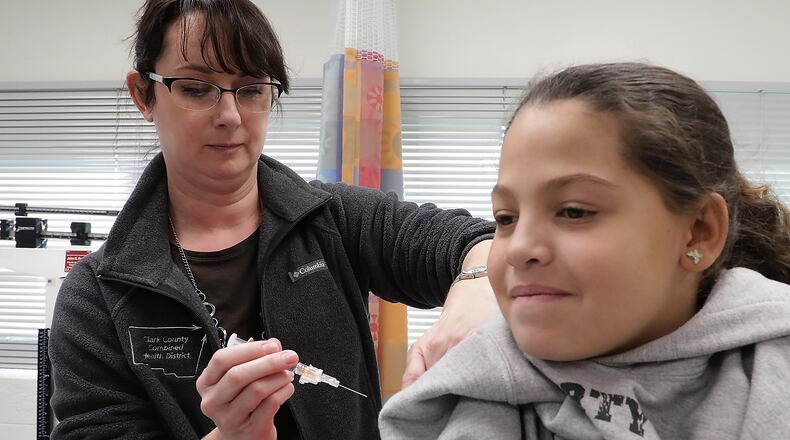“Flu season is upon us,” said Mark Hurst, a medical doctor and the medical director of the Ohio Department of Health. “I know we all love spending time with our loved ones around the holidays, so the most loving thing you could do is get your flu shot, or stay home if you’ve tested positive for the flu.”
RELATED: Flu activity up at start of season, experts recommend vaccines
Two hospitalizations were reported in Greene County in that same period of time and three in Clark County because of the flu. In Warren and Butler counties, there were three and four influenza hospitalizations, respectively.
Hurst said the flu is very unpredictable. This time last year, from the beginning of flu season to Nov. 17, 2018, there were 86 influenza-related hospitalizations — about a quarter less hospitalizations than there have been this year. The year before that saw 130 flu-related hospitalizations up to that same period.
“There is nothing we’re seeing right now that would indicate that this flu season as a whole is going to be worse than in years past,” Hurst said.
However, Hurst said the flu is a serious illness.
“In the average flu season, we lose a number of Ohioans,” Hurst said.
Twenty-two Montgomery County residents died from flu-related complications last year, said Dan Suffoletto, the public information supervisor for Public Health – Dayton & Montgomery County. One of those flu-related deaths was someone younger than 18, and 19 of those deaths were residents who were 65 and older.
RELATED: Dayton Children’s Hospital sees first flu admissions, restricts some visitors
Hurst recommends getting a flu shot as soon as possible. The flu vaccine takes up to two weeks to become fully effective and it is recommended for anyone over six months of age. The only people who should not get a flu shot are those who have had an allergic reaction to the vaccine in the past, Hurst said.
“You want to have an immunity built up so that you don’t spread the flu to your relatives during the holidays, or so that you don’t contract it from your relatives,” Hurst said.
Each year scientists formulate the vaccine based on what types of flu strain they expect. This year the vaccine includes protections against H1N1 and H3N2. It’s still possible to become sick by catching a different strain not covered in the vaccine.
“The more physical contact you have with people increases your chances of getting the flu,” Suffoletto said.
RELATED: Last year’s flue season may be worst in years
It is important for people who think they may have the flu to stay home from work or school, especially around the holidays, said Mark Williams, a physician with Jamestown Family Medicine. People should also consider staying home if they have a fever.
It is also very important for people to cover their mouths with their elbows and not their hands when they cough or sneeze.
Williams said washing hands frequently is the number one thing people can do to try and stay well.
“With the holidays coming up, it is especially important that you wash your hands if you’re preparing food for other people,” Suffoletto said.
Dayton Children’s Hospital had its first flu-related admission about a week ago, prompting the hospital to restrict some visitor access.
Last flu season resulted in four children’s deaths and more than 9,800 hospitalizations in Ohio alone.
Hurst said January and February are typically the peak months for flu-related hospitalizations.
RELATED: What is the flu? 17 things to know about flu symptoms, flu shot side effects and more
By the numbers:
108 — Flu-related hospitalizations in Ohio for the week of Nov. 10-16
86 — Number of hospitalizations during the same period one year ago
8 — Number of hospitalizations in Montgomery County Nov. 10-16
About the Author

